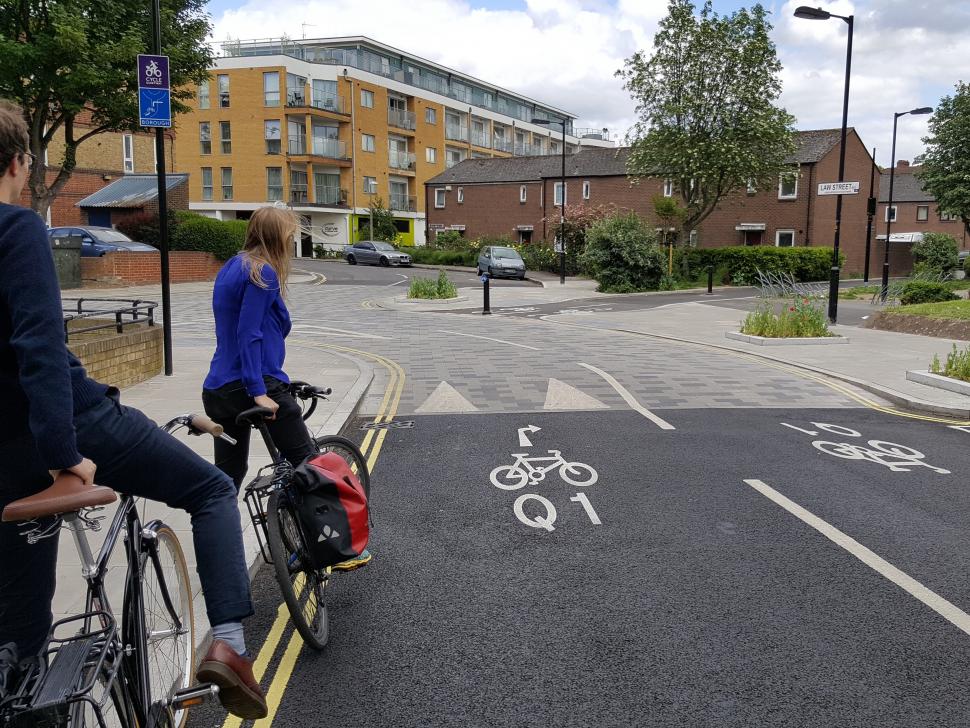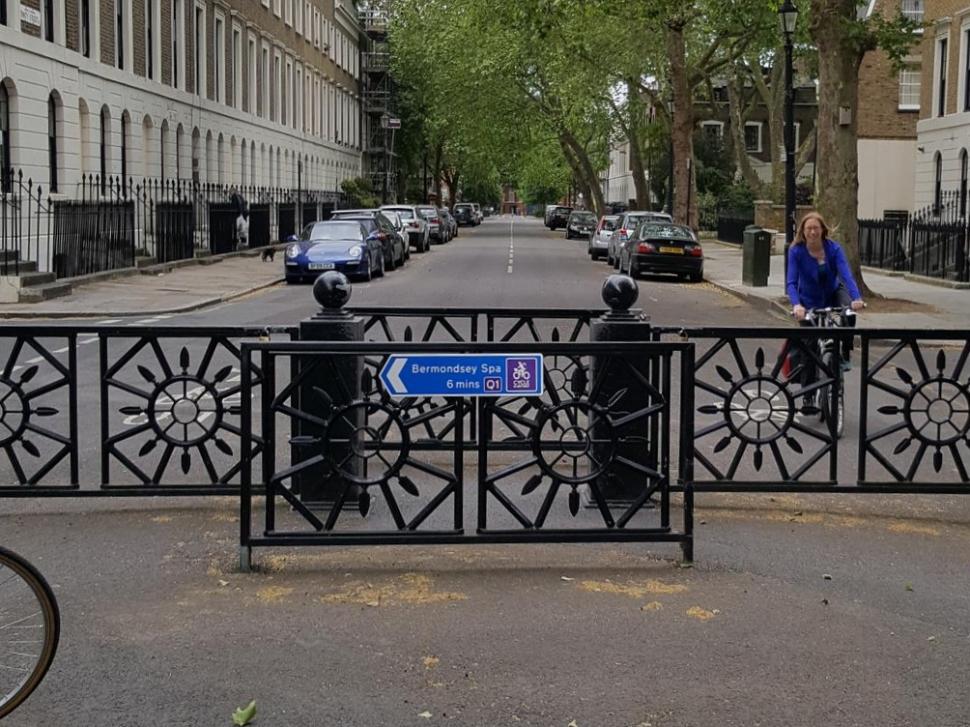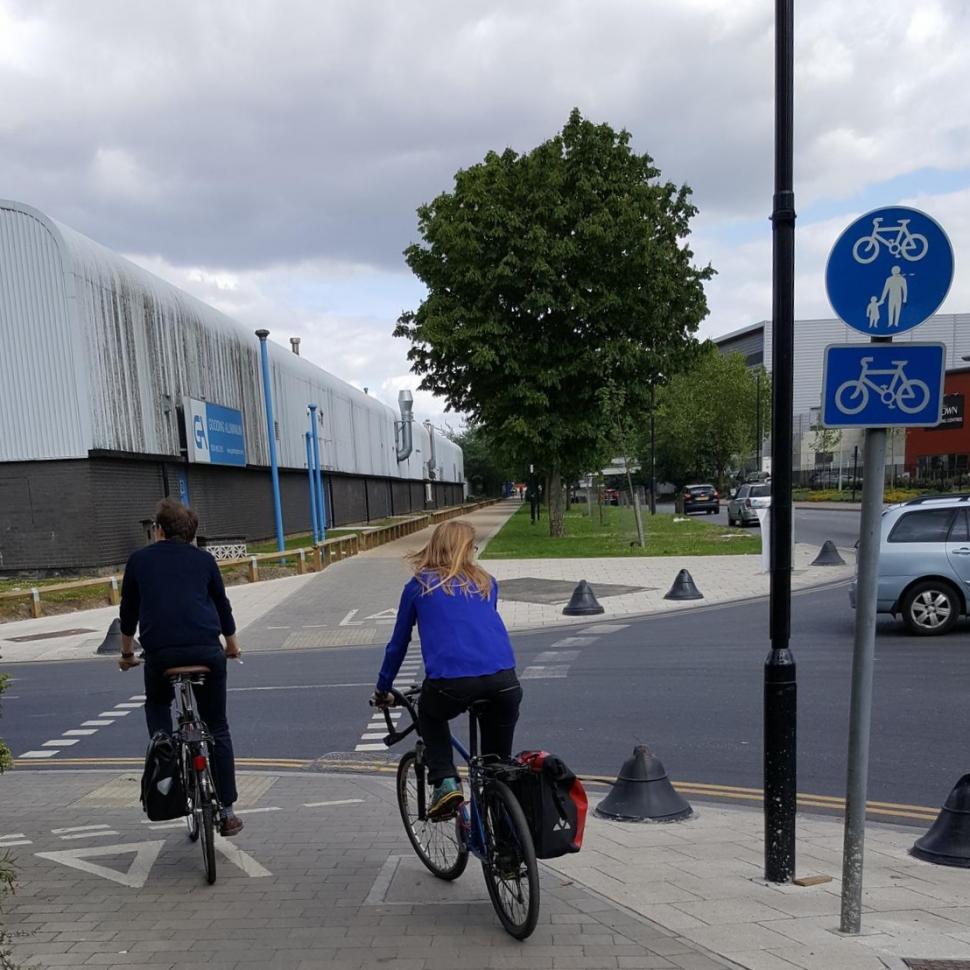- News
- Reviews
- Bikes
- Accessories
- Accessories - misc
- Computer mounts
- Bags
- Bar ends
- Bike bags & cases
- Bottle cages
- Bottles
- Cameras
- Car racks
- Child seats
- Computers
- Glasses
- GPS units
- Helmets
- Lights - front
- Lights - rear
- Lights - sets
- Locks
- Mirrors
- Mudguards
- Racks
- Pumps & CO2 inflators
- Puncture kits
- Reflectives
- Smart watches
- Stands and racks
- Trailers
- Clothing
- Components
- Bar tape & grips
- Bottom brackets
- Brake & gear cables
- Brake & STI levers
- Brake pads & spares
- Brakes
- Cassettes & freewheels
- Chains
- Chainsets & chainrings
- Derailleurs - front
- Derailleurs - rear
- Forks
- Gear levers & shifters
- Groupsets
- Handlebars & extensions
- Headsets
- Hubs
- Inner tubes
- Pedals
- Quick releases & skewers
- Saddles
- Seatposts
- Stems
- Wheels
- Tyres
- Health, fitness and nutrition
- Tools and workshop
- Miscellaneous
- Buyers Guides
- Features
- Forum
- Recommends
- Podcast
news
 Quietway 1 01 copyright Laura Laker.jpg
Quietway 1 01 copyright Laura Laker.jpgLondon's first cycling Quietway officially opens from Greenwich to Waterloo
London’s first Quietway has been officially opened today, running from Greenwich to Waterloo, with the city’s mayor Sadiq Khan saying that he hopes it will make “a significant contribution” towards safer and easier cycling in the capital.
The route, which includes 9 kilometres of what Transport for London (TfL) describes as “quieter backstreets” as well as paths that are free form traffic paths.
It’s the first of seven Quietways currently planned for the capital, although as we reported yesterday, former mayor Boris Johnson’s cycling commissioner, Andrew Gilligan, last week told Hackney Cycling Conference that he believed only the first of those would be of an acceptable quality.
> Gilligan: Quietways programme is a failure
Khan insists, however, that he is committed to getting more Londoners on bikes, and that as part of that he would draw lessons from the infrastructure put in place by his predecessor.
He said: “It is important that we make it safer and easier for Londoners to cycle across our city and we want the first of the Quietways to make a significant contribution towards that aim.
“I am already looking at what works best from the existing cycle schemes to ensure we deliver the best and safest road cycling network possible.
“Cycling leads to a healthier lifestyle, it helps to cut pollution and is a key part of my vision of the type of greener, more modern and affordable transport network we need in our city.”
One of Gilligan’s chief concerns is that since, unlike the Cycle Superhighway (CS) programme, the routes that the Quietways run along are controlled by London boroughs rather than TfL, town halls across the city need to buy into the concept, and he believes the will to do that is lacking in same places.
Quietway 1 itself runs through four boroughs – Greenwich, Lewisham, Southwark and Lambeth – and is signed throughout. It also connects with the North-South Cycle Superhighway CS6 at Webber Street and with CS7 at Great Suffolk Street.
It includes a new 750 metre link over Network Rail land between South Bermondsey station and the Surrey Canal Road path which like the rest of the route is designed to encourage more walking as well as cycling, according to TfL.
TfL’s director of surface strategy and planning, Ben Plowden, commented: “We’re really pleased to see the first Quietway, from Greenwich to Waterloo, open and ready for cyclists and pedestrians to use.
“The Quietway programme along quieter backstreets will help open up a whole new area of London for people walking and cycling and support non-polluting and healthy travel for commuting or leisure.”
Matt Winfield, deputy director of the sustainable transport charity Sustrans, said: “Quietway 1 provides a direct, quick and safe link from Greenwich into Waterloo, and points between. It is another important step in improving the quality of life and economic resilience in our world leading city.”
He added: “We are particularly pleased with the scheme designed and delivered at Millwall Football Club, providing a more direct and car free route for both cyclists and walkers, and a crucial link in this highly useful route.”
Whether campaigners will be similarly enthusiastic about the other planned Quietways – should they be built at all – is open to question.
Last week, talking about local opposition to the Quietway in the borough where he was addressing conference delegates, Gilligan said: “If you can’t get road closures through in Hackney, we need to ask ourselves: is this programme worth anything at all?”
“It is discouraging how little progress there has been on Quietways,” he added.
”We’ve got five segregated Superhighways in place now, on extremely difficult roads, busy roads, with massive traffic, massive political sensitivity, and we did that. We haven’t got a single Quietway route open, not one.”
That at least has now changed.
All pictures copyright Laura Laker.
Simon joined road.cc as news editor in 2009 and is now the site’s community editor, acting as a link between the team producing the content and our readers. A law and languages graduate, published translator and former retail analyst, he has reported on issues as diverse as cycling-related court cases, anti-doping investigations, the latest developments in the bike industry and the sport’s biggest races. Now back in London full-time after 15 years living in Oxford and Cambridge, he loves cycling along the Thames but misses having his former riding buddy, Elodie the miniature schnauzer, in the basket in front of him.
Latest Comments
- wtjs 14 sec ago
Doesn't make any difference if you are hit by the wing mirror- when the police are determined to take no significant action, that's what they do. I...
- HoarseMann 19 min 5 sec ago
It does seem a bit ridiculous having an outright ban on cycles at all times, yet permit holders can drive down there whenever they like and...
- Oldfatgit 26 min 30 sec ago
So much for the First and Second Laws of Robotics.
- Dnnnnnn 47 min 12 sec ago
Well, yes, that's kinda my point. I think stating that "Norway is socialist" is a questionable perspective. I'd say it was a Nordic social...
- Bezzard74 1 hour 3 min ago
The Be Calm section - 100% ...
- don simon fbpe 1 hour 7 min ago
Now, if we're talking gravel bikes, that's a whole different story. Gimme, gimme, gimme! Apologies for the Facebook link....
- wtjs 1 hour 9 min ago
The police are operationally independent, in fact the regional Police and Crime Commissioners have to swear in their oath of office that they will...
- brooksby 1 hour 14 min ago
"'Right", said Fred, "we'll 'ave to get a move on…"
- JohnnyEnglish 2 hours 58 min ago
Thanks for the review. I like that Orbea have included aero extras and wish more manufacturers would stick two fingers up at the UCI - at least in...
- hawkinspeter 2 hours 34 min ago
Excellent - I think I'll replace my emergency tube that is a real squeeze to get into the little Topeak bottle cage bag thingy....





Add new comment
10 comments
I use this route daily, there are a few flaws, but generally this is a good route. partly down to the fact that It follows an old LCN route, which was pretty quiet anyway. Part of Webber street needs resurfacing (as mentioned) and Childers street at the other end (lewisham) is appalling (sadly, as Q1 as been painted over the ruts and potholes, it looks like it will stay this way). The best part is the fantastic new path round Millwall.
I for one applaud this initiative. It'll encourage more people to use their bikes.
Loved to have seen this 17 years ago when I started to commute into Central London.
Self facilitating media nodes?
WTH are "free form traffic paths"? Just sounds like wafflebollocks.
All of these routes seem to do the the same thing over and over: re-enforce centrism. All the paths lead into the centre, but none circumnavigate it. Thats not an integrated cycle network.
Perhaps not, but they do conform to the heaviest demand patterns and that seems like a sensible prioritisation.
What if I want to get from Lewisham to Brixton on a quietway?
Its only catering to those who are mostly commuting, not those that would like to use cycling as an alternate form of transport for getting around.
TfL attitudes (and subsequently their infrastructure design) wont really change or develop to keep pace as long as there is too many people with links to the bus industry in vested positions.
On the basis that there can't instantly be quietways everywhere, prioritising those routes that would offer the greatest benefit to the most people most often seems sensible. Routes into central London are also where the most congestion-alleviating potential exists.
Commuting is one of the most frequent trips that people make. And central London is disproportionately their destination. It's also one where cycling has the most potential to aid the chronic congestion that affects other modes on those routes.
I'm not sure what point you are making: it looks like "it doesn't suit me, therefore it is wrong". This route doesn't help me either but it seems like a sensible thing to have done.
why oh why do they insist on putting vertical-sided kerbs on (especially) narrow cycle lanes? it's a recipe for a spill if you so much as touch them, and you're almost guaranteed to end up under a car or bus that of course wasn't expecting you to end up lying in the road when a second ago you were in a cycle lane. a bevelled kerb by comparison at least gives you a chance to bounce off it, or at the very worst ride up it.
[[[[[ I suppose if cyclists can ride up---and over---a bevelled kerb, impatient drivers (and motorbikers) will use them to overtake (undertake!) slower vehicles ahead. So I'm happy with the segregation these sharp-sided kerbs offer us....but what if we're legally bound to use the Quietway? They're going to get very clogged, in which case I'll rejoin the "traffic", which is what I am---traffic!
Webber Street (top left of the map) is bloody awful. More pot holes than road.
Indeed, good training for Paris-Roubaix on the bit from the NS Super Highway to Waterloo. The other half was resurfaced recently, so fingers crossed they haven't forgotten to finish the job!